Ski Jacket Building: 2L vs. 3L
When you’ve ever shopped round for a ski jacket (or pants), you’re certain to have seen the phrases 2L and 3L (quick for 2-layer and 3-layer) repeatedly. These seek advice from the model of building utilized in a water-proof jacket’s shell, together with the face cloth, waterproof/breathable membrane, and inside liner. Whether or not a ski jacket makes use of a 2- or 3-layer construct has a number of implications for its efficiency, and under we break down the important thing issues. Relaxation assured: Our group of snow-loving editors has examined dozens of designs through the years in all kinds of situations, from dreaded rain-on-snow occasions within the Cascades to blower powder within the Tetons. For extra, try our detailed ski gear opinions.
Editor’s be aware: We up to date this text on September 23, 2024, to incorporate issues about completely different snow climates and tweak a number of product references to replicate 2024-2025 choices.
Desk of Contents
Ski Jacket Building
2-Layer Ski Jackets
Jackets with 2-layer constructions function two key layers: an exterior face cloth and a bonded waterproof/breathable membrane. Additionally they use a dangling liner alongside the inside to guard the membrane from abrasion, pores and skin oils, and many others., usually made out of mesh, taffeta, or gentle nylon. The two-layer jacket class contains each insulated and non-insulated designs—for an insulated jacket, producers place the artificial fill in between the 2-layer shell and the hanging liner. Two-layer ski jackets usually comprise the funds finish of the market (together with fashions like REI Co-op’s $229 Powderbound). Nonetheless, there are a number of premium designs that use high-quality Gore-Tex membranes, such because the Patagonia Storm Shift ($499). We suggest 2-layer ski jackets for resort use solely—as you’ll learn under, their weight/bulk and lack of breathability make them considerably impractical for backcountry use.
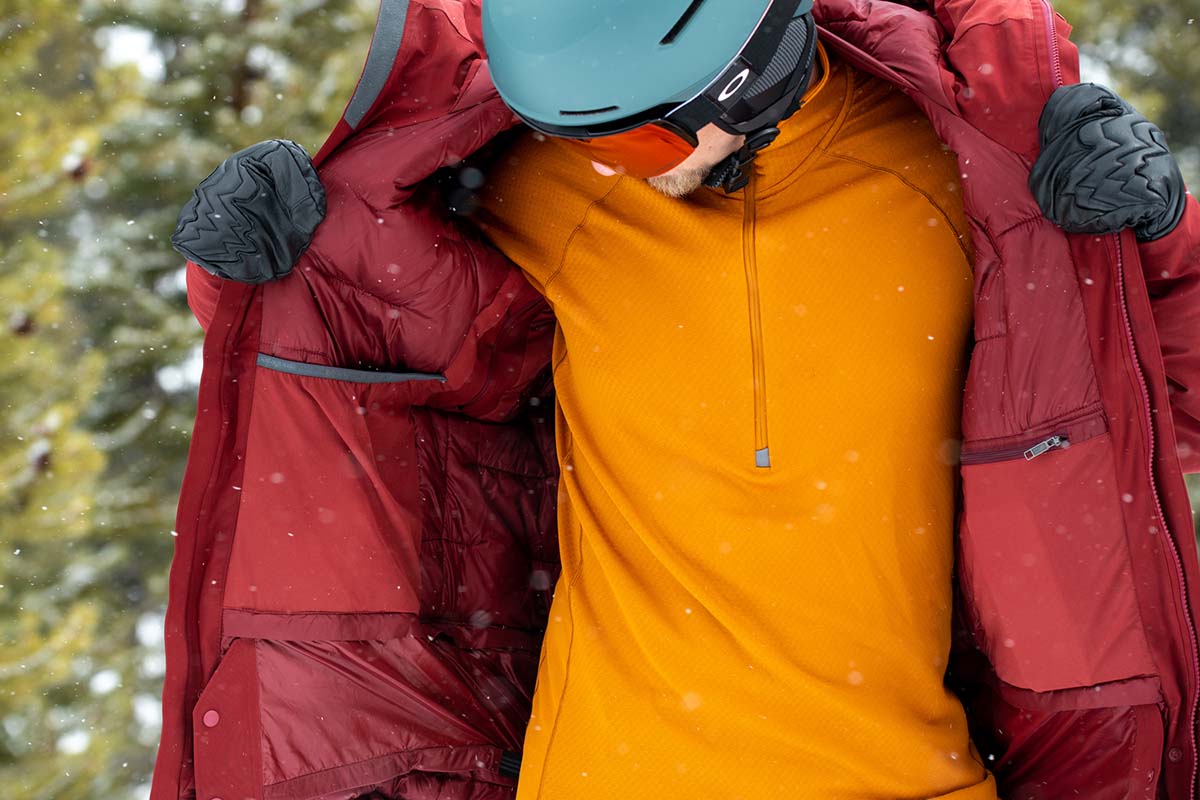
3-Layer Ski Jackets
Much like 2-layer ski jackets, 3-layer designs function a water-proof membrane bonded to the outside face cloth. The place they differ is in using an built-in liner fairly than a dangling liner. This liner is affixed on to the within of the membrane, leading to a sleeker and lighter design that’s far more breathable than a 2-layer jacket. Basically, 3-layer jackets are purely shells—insulated designs are very uncommon—and their streamlined building leads to larger worth tags (there are some exceptions to this rule). For instance, our top-ranked Arc’teryx Sabre is a whopping $750, however a number of mid-range choices (together with the Rab Khroma Kinetic) will run you nearer to $400. Their low weight, minimal bulk, and spectacular breathability make 3-layer jackets a superb alternative for backcountry use, however they’re additionally versatile for the resort.
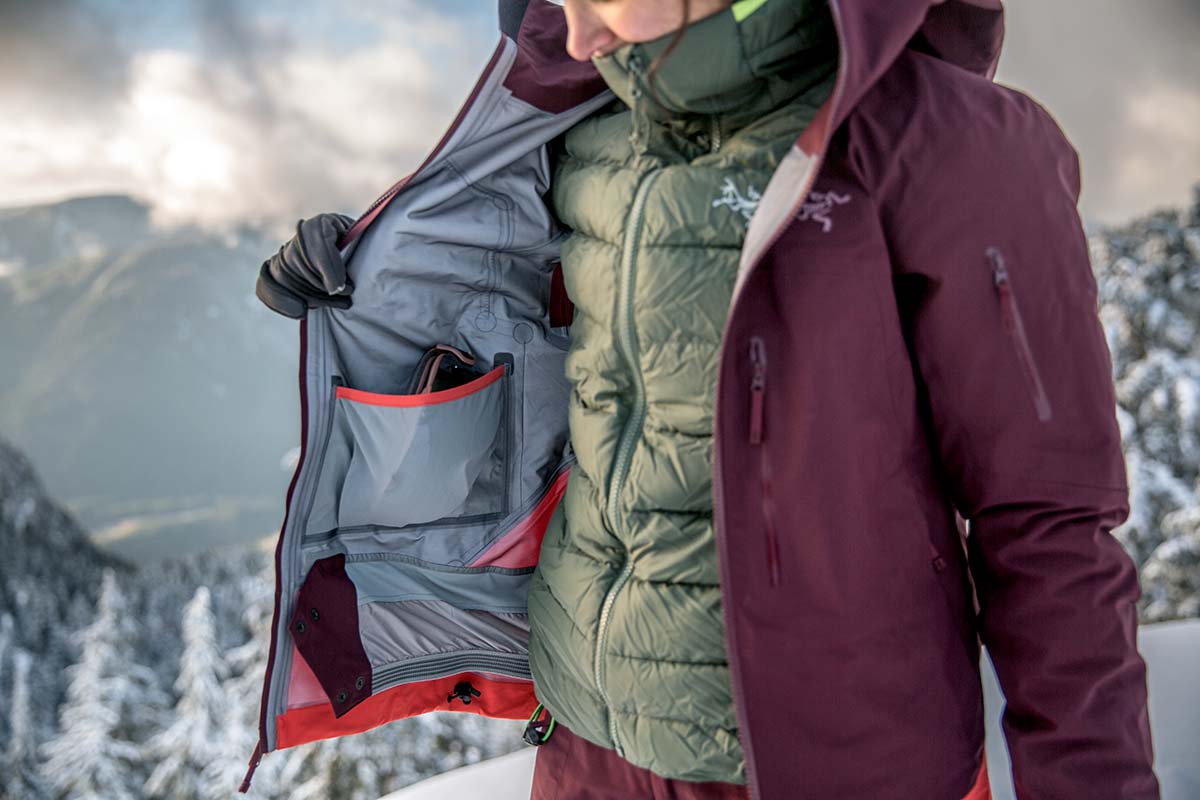
2L vs. 3L: Key Issues
Breathability Benefit: 3L
Breathability is likely one of the most important methods wherein 2- and 3-layer constructions diverge. As a result of added bulk of their hanging mesh or taffeta liner, 2-layer jackets can lure warmth and turn out to be pretty swampy in gentle situations or throughout high-output exercise. Alternatively, a 3-layer jacket’s modern liner does little or no to inhibit the membrane’s breathability. Regardless of their subpar efficiency, 2-layer ski jackets are completely serviceable for many resort snowboarding, particularly for informal skiers who stick primarily to groomers (unzipping the pit vents may help with airflow, too). In case your model of snowboarding entails mountaineering out of bounds or the odd day of backcountry touring, we strongly suggest choosing a 3-layer jacket.
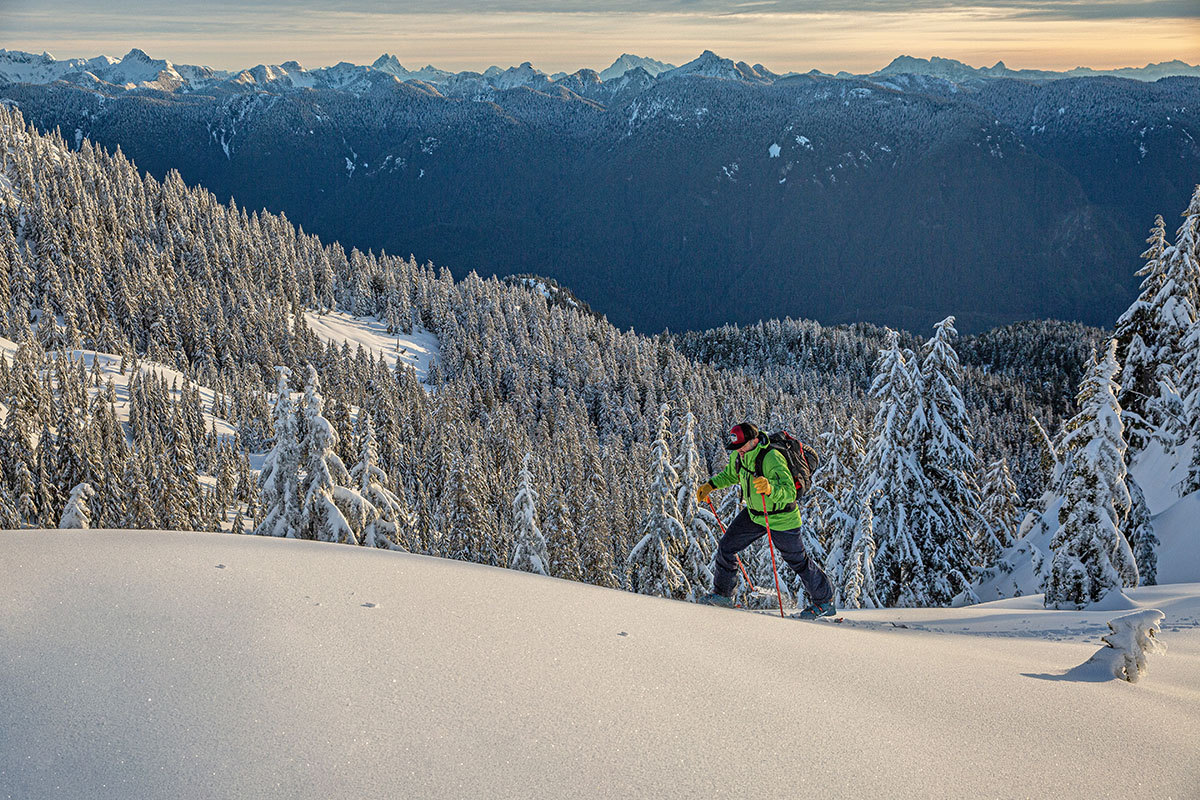
Waterproofing Benefit: It Relies upon
All else being equal, 2- and 3-layer jackets provide an identical degree of waterproofing. Each constructions embrace a water-proof/breathable membrane, which is very engineered to limit moisture getting into from the surface whereas permitting air to stream from the within out. After all, you may wish to think about the standard of the membrane: Two-layer jackets usually make use of extra entry-level, in-house membranes, whereas 3-layer jackets are decidedly extra premium and extra possible to make use of top-shelf membranes like Gore-Tex. However this isn’t at all times the case—for instance, the Arc’teryx Sabre (3L) and Patagonia Storm Shift (2L) each use the identical high-end Gore-Tex membrane.
There are just a few extra components to contemplate when occupied with waterproofing. The primary is shell thickness: The thicker the shell, the extra resistant it is going to be to wetting out. Basically, 2-layer jackets are likely to have thicker shells (as weight is much less of a precedence), however we’ve discovered that almost all shells round 70-denier (D) and thicker are reliably storm-worthy, together with the 80D shell on the Arc’teryx Sabre (3L). One other issue is seam-sealing: Most high quality ski jackets function tape on each seam, however funds designs are solely taped on the crucial seams, together with these on the shoulders, again, and hood. You’d be hard-pressed to discover a 3-layer jacket that isn’t absolutely seam taped, whereas some entry-level 2-layer designs are simply critically seam taped. Be sure you take note of this element, as it’ll influence your jacket’s waterproofing throughout lengthy and moist days on the slopes.
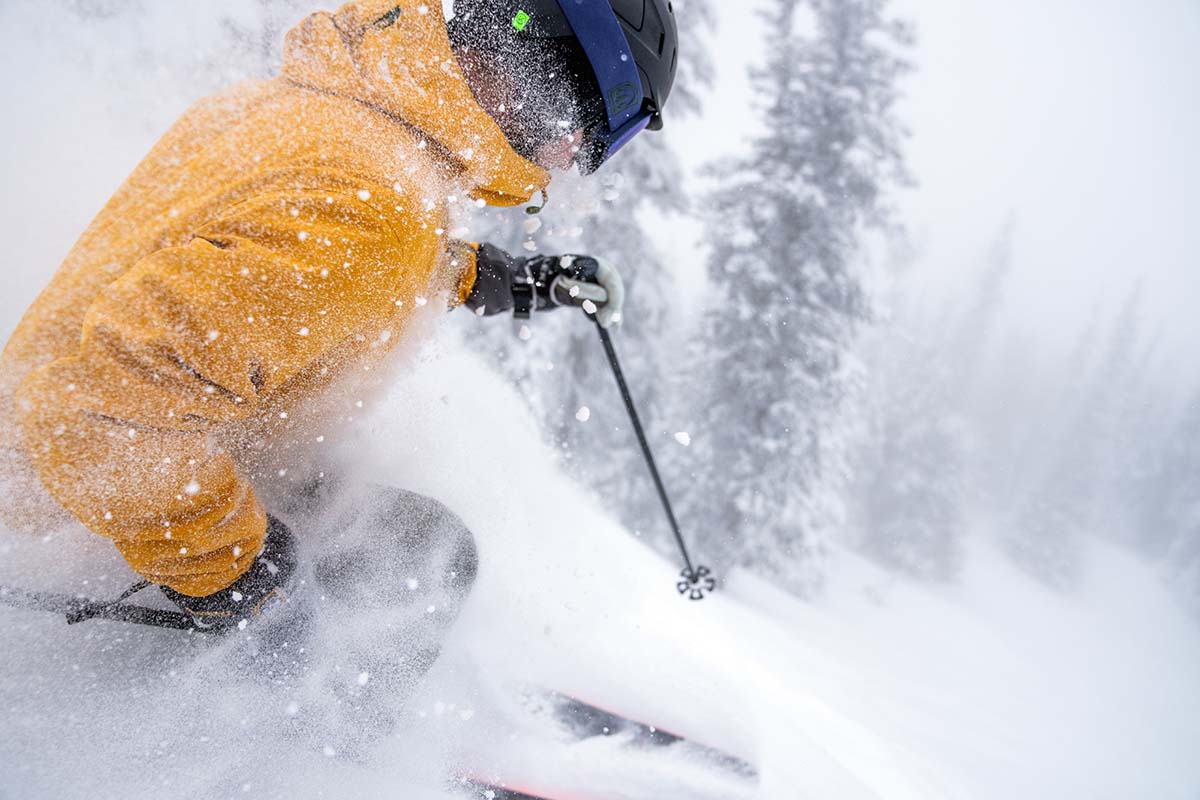
Heat Benefit: 2L
Due to their additional hanging layer, 2-layer jackets will be hotter than 3-layer jackets. This building also can accommodate insulation between the 2-layer shell and the hanging liner, whereas 3-layer jackets are nearly at all times uninsulated (Arc’teryx’s dear 3L Macai is one exception). In consequence, each uninsulated and insulated 2-layer jackets (just like the Trew Gear Jefferson and Patagonia Storm Shift, respectively) are effectively suited to resort skiers, particularly in significantly chilly areas just like the Rockies or the Northeast. For milder climates or skiers who construct warmth whereas exploring the slack- or backcountry, the additional heat is much less of a boon, particularly given its influence on breathability.
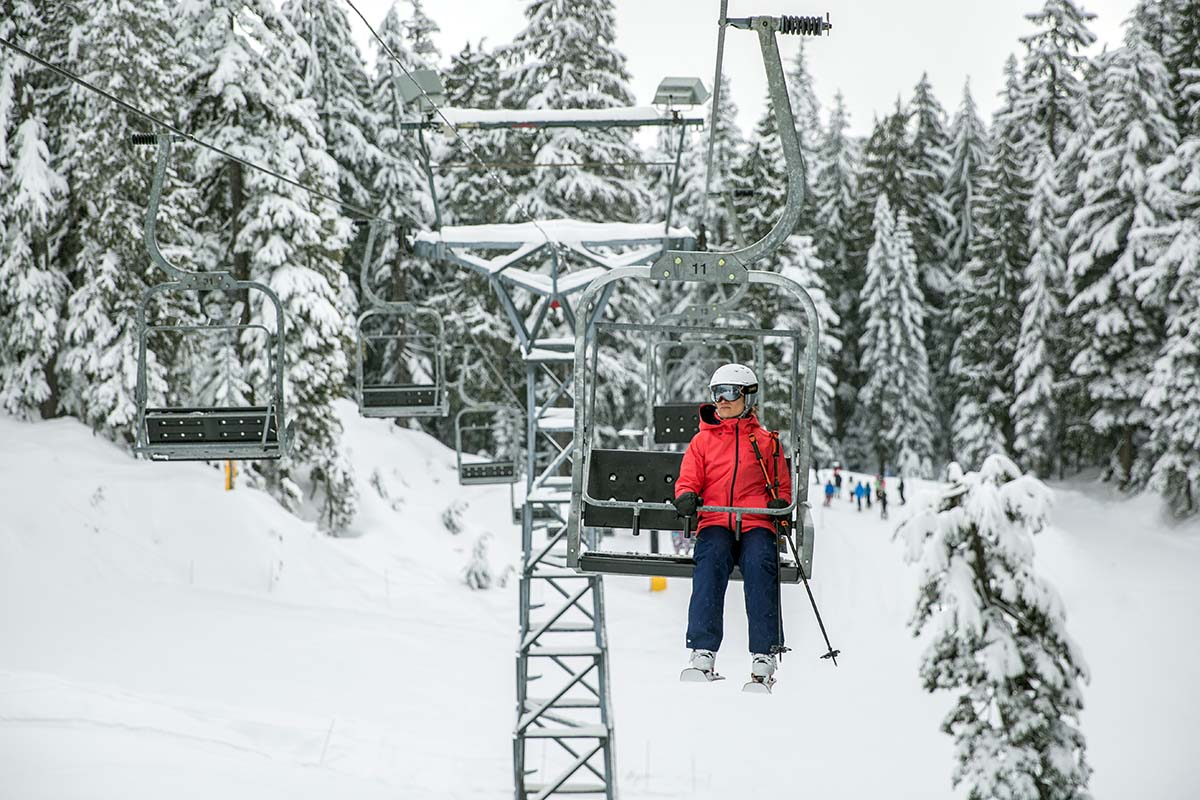
Weight and Bulk Benefit: 3L
Together with breathability and heat, a jacket’s weight and bulk differ fairly a bit between 2- and 3-layer designs. The hanging liner utilized in a 2-layer jacket provides a big quantity of material to the general jacket. In distinction, the streamlined hooked up liner (third layer) of a 3-layer jacket is nearly imperceptible. As an instance, think about the 11.1-ounce distinction between the 3-layer Rab Khroma Kinetic (1 lb. 2.9 oz.) and 2-layer Trew Gear Jefferson (1 lb. 14 oz.).Whereas nearly all of resort skiers gained’t be involved with further weight and bulk, it’s a consideration for these headed out of bounds or deep into the backcountry—for human-powered actions, you’ll need a streamlined 3-layer jacket that gained’t be a pressure in your shoulders or inhibit motion and might stuff down right into a nook of your pack.
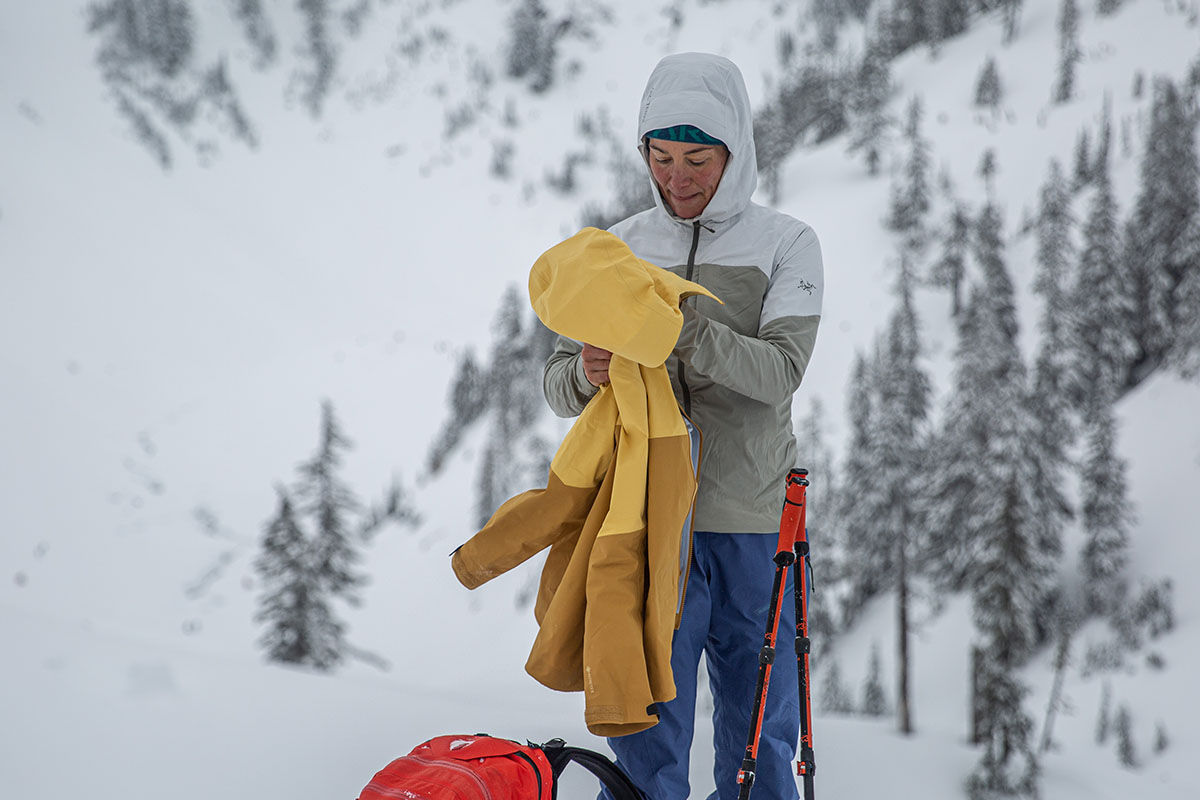
Sturdiness Benefit: It Relies upon
Most ski jackets are decently sturdy, together with each 2- and 3-layer designs. Basically, sturdiness is a perform of the thickness of the shell cloth (expressed as denier) and the general construct high quality of the jacket. Shell denier can range wildly in each 2- and 3-layer jackets—as examples, the Patagonia Storm Shift (2L) incorporates a burly 150D shell, the Outside Analysis Carbide (3L) has a skinny 40D shell, and the Arc’teryx Sabre (3L) lands within the center with 80D nylon. Typically talking (and there are lots of exceptions to this rule), it is not uncommon to see thicker supplies in 2-layer jackets. It is because most 2-layer jackets are meant for resort use, the place a hardwearing shell takes priority over breathability and weight-savings.
Concerning construct high quality, nearly all 3-layer jackets are on the premium finish of the spectrum and exude a excessive consideration to element, whereas some (however not all) 2-layer jackets earn their lower cost factors with downgraded construct high quality. However chairlift laps and 60-day seasons can put a number of put on on a jacket—resort skiers who get out loads will wish to go for a high-end 2-layer jacket (just like the Patagonia Storm Shift or Helly Hansen Alpha 4.0) or a 3-layer shell with thick face cloth (search for 70D or larger). Alternatively, backcountry skiers will wish to shave weight and bulk with a 3-layer jacket—however remember the fact that the thinner varieties do compromise a bit on sturdiness.
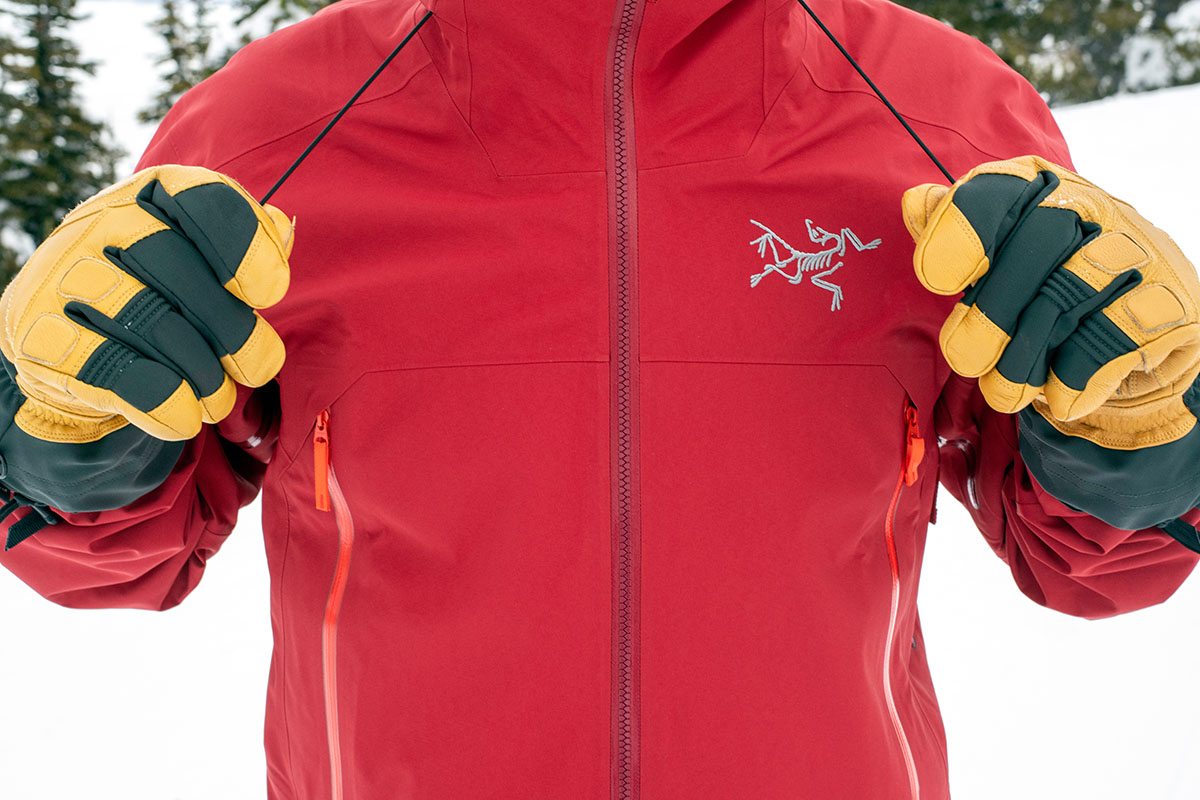
Value Benefit: 2L
Value is the ultimate consideration within the 2-layer versus 3-layer debate. With just a few exceptions, 2-layer jackets are extra reasonably priced than 3-layer designs and a very good alternative for resort skiers attempting to avoid wasting a buck or two. For instance, our top-ranked Arc’teryx Sabre (3L Gore-Tex) will set you again $750, whereas the REI Co-op First Chair GTX (2L Gore-Tex) is simply $319. These jackets provide related ranges of waterproofing with the identical Gore-Tex membrane, however the Sabre is barely lighter, much less cumbersome, and extra breathable. Funds 2-layer jackets can dip as little as $200, however keep in mind these designs are pretty compromised and never a terrific alternative for many who get out loads.
As we talked about, although, there are just a few outliers. Outside Analysis’s Carbide, for instance, is a $329 3-layer jacket (a whopping $421 lower than the aforementioned Sabre)—nevertheless it does compromise on climate safety and sturdiness with the lower-quality Pertex membrane and skinny, 40D shell. After which there’s Patagonia’s premium Storm Shift: a 2-layer jacket that’s $170 greater than the Carbide at $499. Nevertheless, the Storm Shift incorporates a top-shelf Gore-Tex membrane, a sturdy 150D face cloth, a comfortable fleece liner, and actually spectacular construct high quality. All advised, anticipate 2-layer jackets to run you between $200 and $500, whereas 3-layer designs are $300 to $700 (or extra).
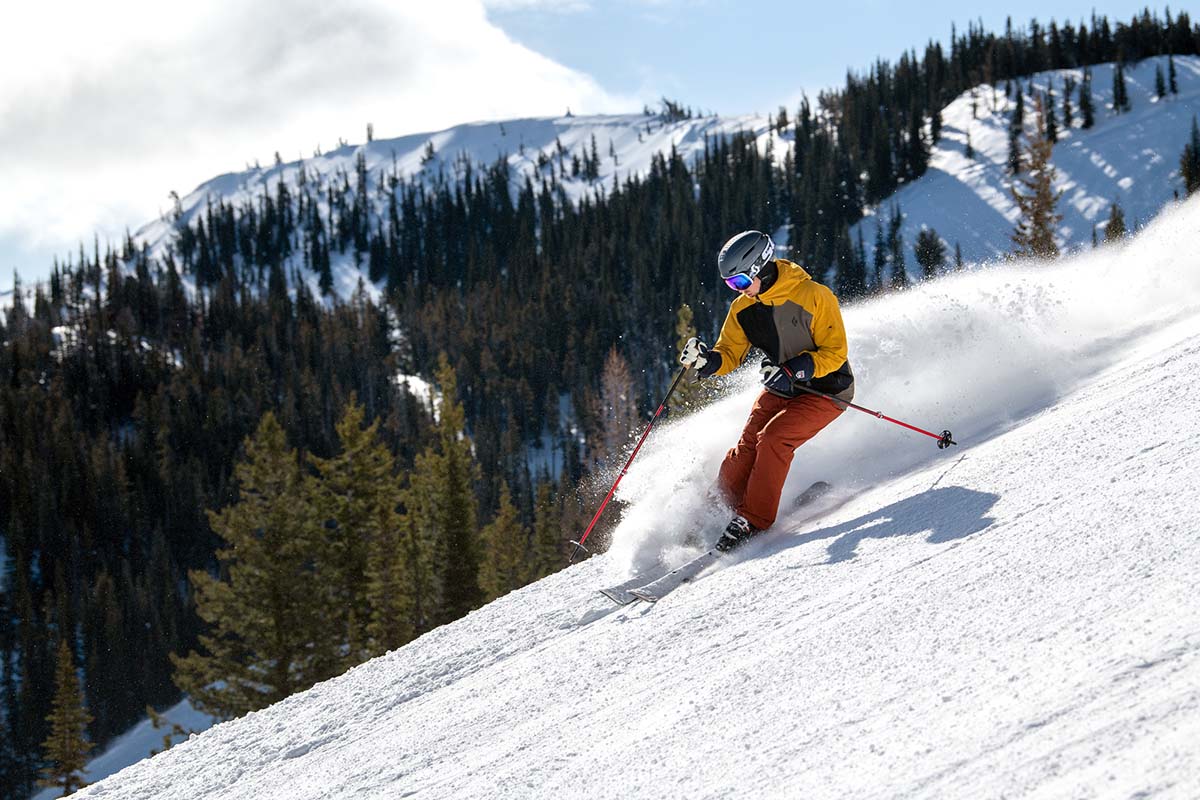
Meant Makes use of
By now, the variations between 2- and 3-layer building needs to be pretty clear. Each will be high-quality and extremely waterproof, however 3-layer jackets get the sting when it comes to breathability and weight/bulk. Alternatively, 2-layer jackets are hotter (and infrequently insulated) and usually the extra reasonably priced of the 2. So, which model of ski jacket is greatest for you?
Resort Use
In our opinion, most resort skiers will likely be effectively matched with a 2-layer jacket. The dip in breathability gained’t be an enormous deal while you’re driving the chairlift and cruising groomers, and the additional dose of heat will likely be a boon in most situations. Furthermore, many 2-layer jackets use significantly thick shell materials and are ready to deal with the pains of resort use. And if you happen to’re involved about high quality, there are a variety of premium 2-layer designs, together with the Patagonia Storm Shift and Helly Hansen Alpha 4.0. Alternatively, many will go for a 2-layer design to avoid wasting money, wherein case jackets just like the REI Co-op Powderbound ($229) and First Chair GTX ($319), Trew Gear Jefferson and Astoria ($319), and Columbia Bugaboo ($210) make glorious choices.
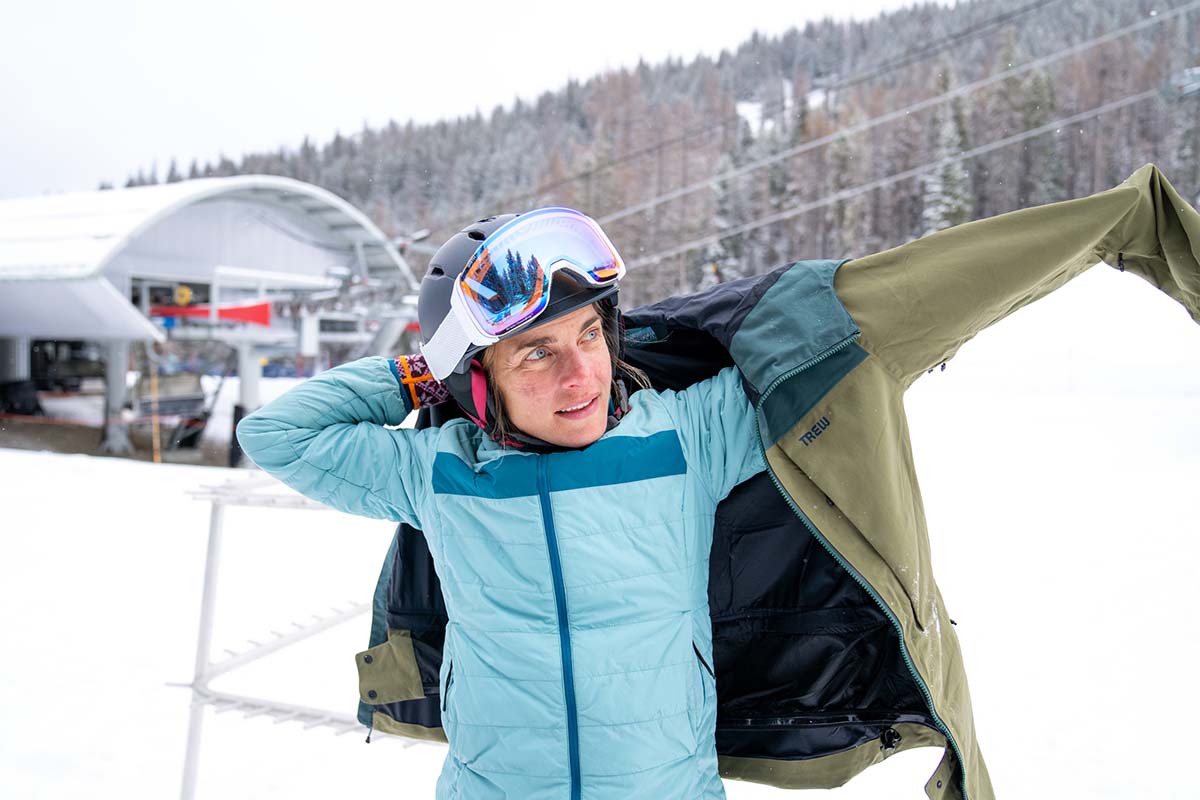
Backcountry Use
When you’re a backcountry skier or prefer to enterprise out of bounds on the resort sometimes, a 3-layer jacket is the extra high-performance and versatile choice. The increase in breathability is pretty crucial for high-output skinning, mountaineering, and boot packing, and the streamlined weight and bulk will make a distinction throughout lengthy slogs or if you wish to stuff your jacket in your ski pack on the uphill. Lastly, whereas 3-layer designs aren’t normally insulated, the easy shell makes it simpler to tailor your layers to the day’s situations, whether or not you want to add a midlayer, select a thinner baselayer, or swap in artificial for down. As we talked about above, 3-layer designs do cowl the premium finish of the market, however there are a rising variety of extra reasonably priced—however nonetheless very high-quality—choices to contemplate, together with the Outside Analysis Carbide ($329), Flylow Malone ($400), and Trew Gear Cosmic ($459).
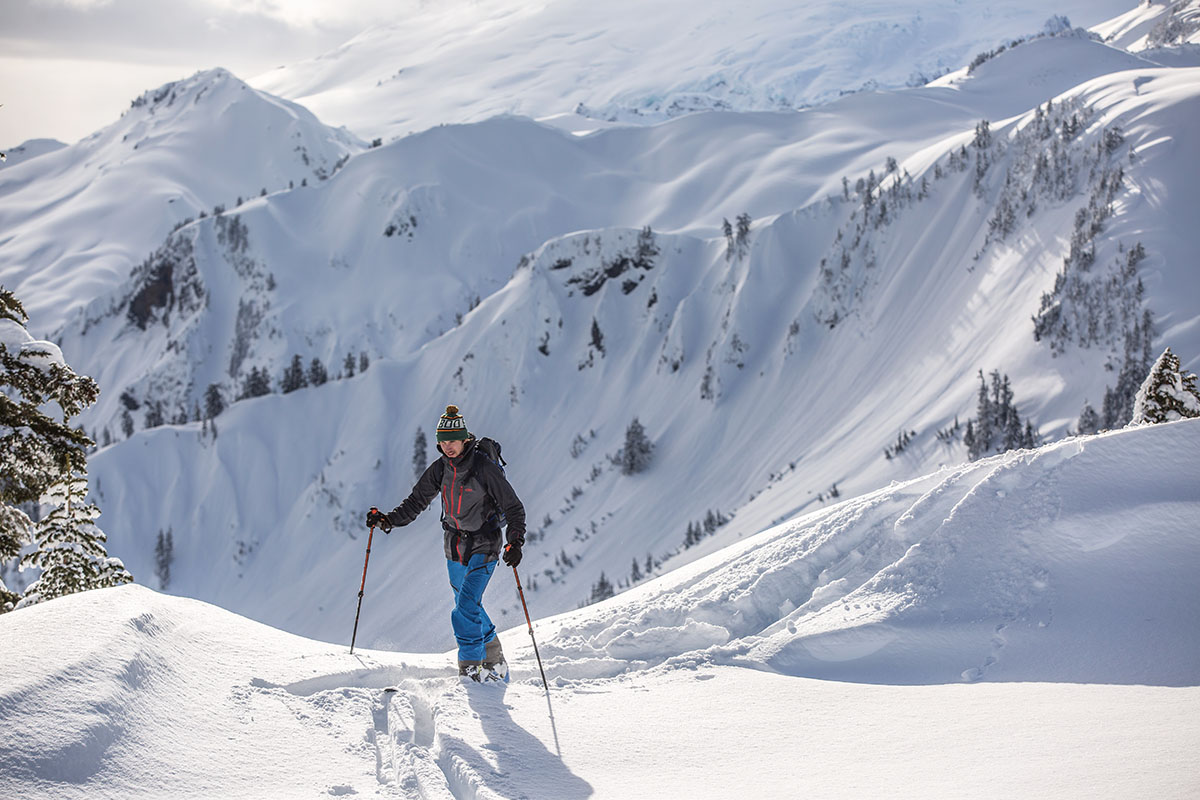
Totally different Snow Climates
Whereas a few of us could also be touring between the moist and wild storm days of western Washington to the dry chilly of the Colorado Rockies on the common, most skiers will spend most of their days out in a single snow local weather. There are three most important “snow climates,” or buckets of varieties of snowfall that share frequent traits: Maritime, Continental, and Intermountain. Maritime climates sometimes encompass wetter, hotter, and heavier snow (suppose the Cascade concrete of Mt. Baker), justifying the added expense of a thick and absolutely seam-sealed 3-layer design. Alternatively, a Colorado native residing within the Continental dry, chilly, and windy setting of Steamboat Springs could decide to prioritize heat above all else by choosing an insulated 2-layer design. And for riders who primarily ski in an Intermountain snowpack, which shares traits of each Maritime and Continental areas, the purpose will possible be balanced efficiency over all-out safety or chart-topping heat.
Our High Ski Jacket Picks
Nailing down the kind of jacket that is greatest for you is a vital early step within the shopping for course of. Under are our group’s high 2- and 3-layer choices, together with premium, mid-range, and funds picks. For much more choices, see our articles on the most effective ski jackets and greatest ladies’s ski jackets.
Premium 3L: Arc’teryx Sabre and Sentinel ($750)
Mid-range 3L: Flylow Malone and Lucy ($400)
Funds 3L: Outside Analysis Carbide ($329)
Premium 2L: Patagonia Storm Shift ($499)
Insulated 2L: Helly Hansen Alpha 4.0 and Alphelia ($475)
Mid-range 2L: Trew Gear Jefferson and Astoria ($319)
Funds 2L: REI Co-op Powderbound ($229)
Again to Our Ski Jacket Building Information See Our Ski Gear Evaluations






.jpg?w=1200&resize=1200,0&ssl=1)